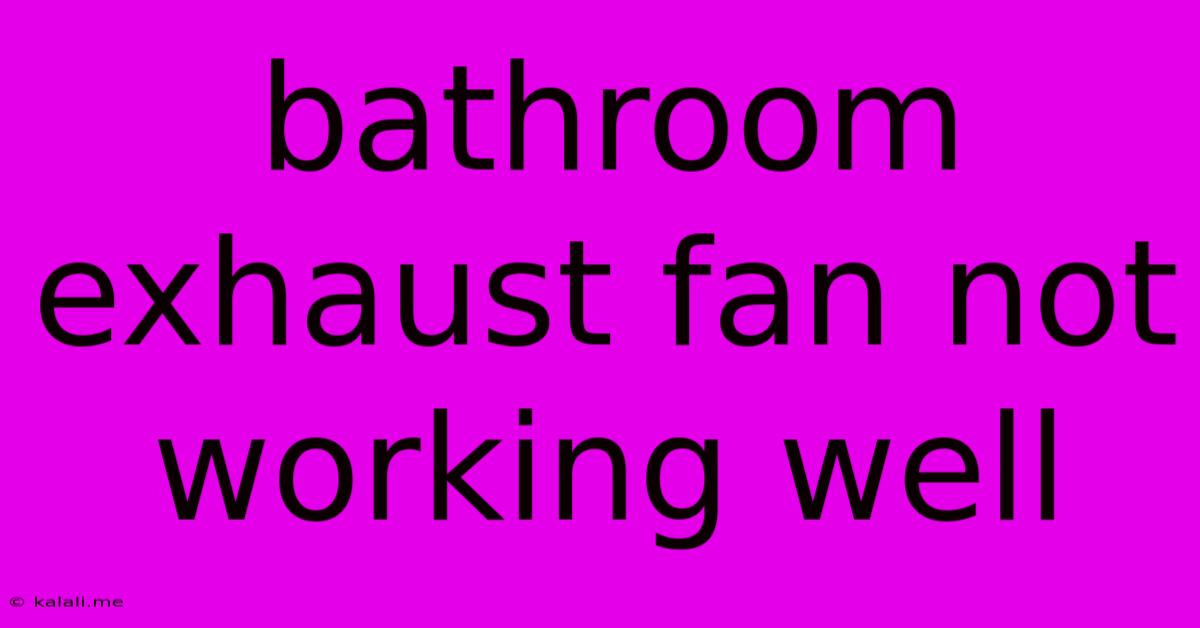Bathroom Exhaust Fan Not Working Well
Kalali
Jun 05, 2025 · 3 min read

Table of Contents
Bathroom Exhaust Fan Not Working Well? Troubleshooting Tips and Solutions
Is your bathroom exhaust fan struggling to do its job? A poorly functioning fan can lead to excessive moisture, mold growth, and unpleasant odors, impacting both the health and aesthetic appeal of your bathroom. This article will guide you through troubleshooting common problems and finding solutions to get your fan back in tip-top shape. We'll cover everything from simple fixes you can try yourself to when it's time to call in a professional.
Common Causes of a Weak or Non-Functional Bathroom Exhaust Fan
Several factors can contribute to a poorly performing bathroom exhaust fan. Let's explore the most frequent culprits:
1. Clogged Fan Blades or Housing
Over time, dust, lint, and other debris can accumulate on the fan blades and within the housing, restricting airflow and reducing the fan's efficiency. This is often the simplest problem to resolve.
- Solution: Turn off the power to the fan at the breaker box. Carefully remove the fan cover (usually held in place by clips or screws). Use a soft brush or vacuum cleaner with a brush attachment to gently clean the fan blades and housing. Pay close attention to removing any obstructions within the vent ductwork. Reassemble the fan and test its performance.
2. Faulty Motor or Capacitor
The motor is the heart of the exhaust fan. A worn-out motor or a malfunctioning capacitor (which helps the motor start) can lead to a weak or completely inoperative fan. These issues often require professional attention or replacement parts.
- Solution: If cleaning doesn't resolve the issue, the motor or capacitor might be faulty. Listen carefully; a struggling motor might make unusual noises. Replacing these components usually involves some electrical expertise, so unless you're comfortable working with electricity, calling an electrician is advisable.
3. Blocked Vent Duct
The vent ductwork, which extends from the fan to the outside of your house, can become obstructed with debris, bird nests, or even ice (in colder climates). A blocked duct severely restricts airflow, rendering the fan ineffective.
- Solution: Access the vent duct from both the inside (via the fan housing) and the outside (usually a vent cover on the exterior wall). Carefully remove any obstructions. For stubborn blockages, you may need specialized tools. Consider professional cleaning for extensive ductwork cleaning.
4. Worn-Out Bearings
Over time, the bearings supporting the fan motor can wear down, leading to a noisy and inefficient fan. Replacing worn bearings often requires technical expertise.
- Solution: If you hear grinding or squeaking noises from the fan, worn bearings are a likely culprit. Repairing this generally requires disassembling the fan and replacing the bearings, best left to someone with experience in motor repair.
5. Switch Problems
The wall switch controlling the fan could be faulty. A broken switch won't send power to the fan, even if the fan itself is working fine.
- Solution: Test the switch using a multimeter to check for continuity. If the switch is malfunctioning, it will need to be replaced. This is often a relatively simple DIY task, but if you're uncomfortable with electrical work, call an electrician.
6. Power Supply Issues
Check the breaker box to ensure the circuit breaker for the bathroom fan hasn't tripped. Also, verify that the power cord is securely connected to both the fan and the power source.
- Solution: Reset the breaker if it's tripped. Check all connections for loose wires.
When to Call a Professional
While some issues can be tackled with basic DIY skills, it's crucial to recognize when professional help is needed. This is particularly true if you're uncomfortable working with electricity or if the problem involves complex repairs like motor or bearing replacement. Calling a qualified electrician is always a safe option.
By systematically checking these common causes, you can often identify and resolve the issue behind your poorly functioning bathroom exhaust fan, ensuring a healthy and comfortable bathroom environment. Remember to prioritize safety and call a professional if you’re unsure about any of the troubleshooting steps.
Latest Posts
Latest Posts
-
Temperature Of Water Knowing Outside Pipe Temperature
Jun 07, 2025
-
Unless A Seed Falls To The Ground And Dies
Jun 07, 2025
-
How To Clean A Black Stove Top
Jun 07, 2025
-
Electric Water Heater Will Not Heat
Jun 07, 2025
-
How To Fix Smoke Detector Chirping
Jun 07, 2025
Related Post
Thank you for visiting our website which covers about Bathroom Exhaust Fan Not Working Well . We hope the information provided has been useful to you. Feel free to contact us if you have any questions or need further assistance. See you next time and don't miss to bookmark.